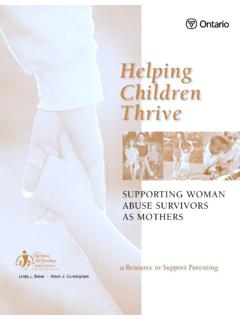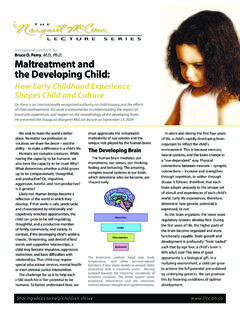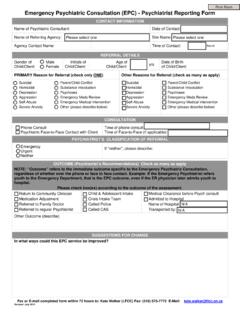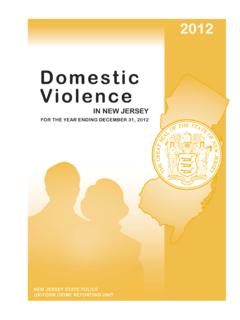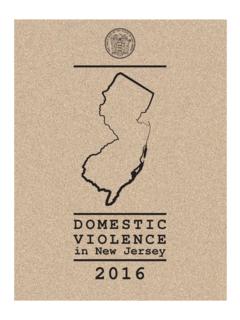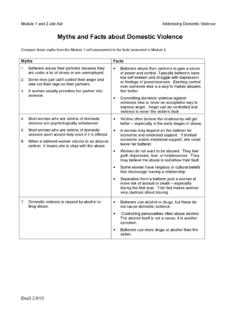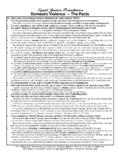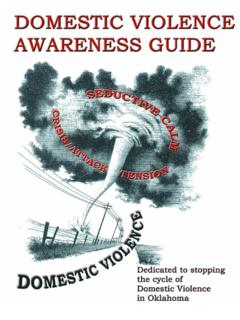Transcription of Children Exposed to Domestic Violence - Homepage - LFCC
1 Children Exposed to Domestic ViolenceAn Early Childhood Educator sHandbook to IncreaseUnderstanding and ImproveCommunity Responses Sponsored by The David and Lucile Packard FoundationLinda L. BakerPeter G. JaffeLynda AshbourneJanet CarterCentre for Children & Familiesin the Justice SystemAn Early Childhood Educator s Handbook to IncreaseAn Early Childhood Educator s Handbook to IncreaseUnderstanding and Improve Community ResponsesUnderstanding and Improve Community ResponsesChildren Exposed to Domestic ViolenceChildren Exposed to Domestic ViolenceThe Importance of this TopicWhy you need to knowHow this handbook can helpDefinitionsWhat is it?Power & Control WheelFindings from the National Violence Against Women SurveyImpacts on ChildrenPotential Impacts at Different AgesSigns a Child is Having DifficultiesSupportive ResponsesResponding When Children Display Troubling BehaviorsStrategies for Challenging BehaviorsEffective ProgramsWhen a Parent is a Victim of Domestic ViolenceWays to Support a Child Who Makes a DisclosureGuidelines to Assist with Decision Making and RespondingReporting to Child Protection ServicesSafety PlanningLauren s StoryEnrico s StoryWhere to Go for HelpEnglish Pamphlet for ParentsSpanish Pamphlet for ParentsResourcesReferences2234567891011& 1213&14151617&18192021&2223242526&2728&2 93031 INDEXThe support of The David andLucile Packard Foundationisgratefully views expressed herein arethose of the Centre for Childrenand Families in the JusticeSystem of the London FamilyCourt Clinic.
2 Inc. and do notnecessarily reflect those of TheDavid and Lucile :Linda L. BakerPeter G. JaffeLynda AshbourneJanet CarterGraphic Design:Jeanie MacWilliamHow to Order:This handbook can be obtainedfrom the Centre for Children &Families in the Justice System website: , orFamily Violence Prevention Fundwebsite: write to:Centre for Children & Families in theJustice System, 254 Pall Mall St.,Suite 200, London, ON N6A 5P6 or call:(519)679-7250 ext. 206or email: content of this handbook cannotbe reproduced for publication without the written permission ofthe Centre for Children andFamilies in the Justice 2002 Centre forChildren & Families in the JusticeSystemISBN # 1-895953-13-81 The Importance of this TopicThe Importance of this TopicWhy you need to knowWhy you need to knowEach year in the US, millions of Children are Exposed to Violence in their homes, schools, neighborhoods, and through the ,2,3,4 Young Children are most likely toexperience Domestic Violence abusive behavior used by one intimate partner to control and dominate the other.
3 The young child s need for predictability and consistencyis threatened by Domestic Violence . Routines are likely interrupted, and the sounds and images are distressing. Individuals like you, who care for and teach young Children , are in an ideal position to support their adjustment. Children under age five are more likely to live in a household where Domestic Violence occurs than are Children in any other age Children living with Domestic Violence are at risk for increased emotional and behavioral ,5 Early identification of difficulties can lead to earlier and more effective support and intervention for Children and their Early childhood programs can be a secure and nurturing place for vulnerable Children . The caring adults who work in these programs can make a difference in the life of a child who is affected by this handbook can helpHow this handbook can helpThis handbook contains information that will help you: learn about Domestic Violence and its impact on young Children ; recognize the signs that Children may display when they are having difficulties.
4 These signs may occur for a variety of reasons, including Domestic Violence ; learn ways to support Children and deal with challenging behaviors; offer support and information about resources to parents who may be adult victims of Domestic Violence . (See pamphlets for parents English on page 26 and Spanish on page 28.)2 DefinitionsDefinitionsEarly childhood educator is an inclusive term that refers to individuals who are working with Children under six in a variety of programs, including childcare, nursery school and kindergarten. It is used interchangeably withearly childhood workersand childhood program refers to programs for Children under six years, including childcare in homes and in agencies, nursery schools, Headstart programs, and Violence refers to the abuse and/or assault of adolescents or adults by their intimate partners. It is used interchangeably with intimate partner abuse and inter-parental is often used to refer to Domestic Violence or frequent and severe refers to individuals who are violent toward their intimate partners.
5 It is used interchangeably with offenders, offending parents, batterers,abusive partners, refers to individuals who are abused by their intimate partners. It is used interchangeably with survivor, victimized parent, abused partner,adult victim and battered Domestic Violence advocates prefer the term survivor, as it reflects the reality that many abused individuals cope and move on with personal strength and Exposed to Domestic Violence refers to Children seeing, hearing or being aware of Violence against one parent figure that is perpetrated by another parent figure. It is used interchangeably with Children living with is it?What is it?Understanding Domestic Violence helps us support Understanding Domestic Violence helps us support affected occurs in all age, racial, socioeconomic, educational, occupational and religious groups; occurs within an intimate relationship; typically involves repetitive behavior including different types of abuse physical assault, psychological, emotional and economical abuse, and use of Children (see Power and Control Wheel, page 5); is used to intimidate, humiliate or frighten victims as a systematic way of maintaining power and control over them; is abusive behavior that in most cases has been learned by the batterer ( , abusive behavior modeled in family of origin; abusive behavior rewarded gets desired results for perpetrator); is caused by the perpetratorand not by the victim or the relationship.
6 Is a criminal offense where actual or threatened physical or sexual force is used; differentially affects men and women: women experience more Violence over a lifetime, more severe forms of Violence and more serious injuries than do male victims;7 may present increased risk to the victim and Children at the time of separation from the abuser;8 results in victim behavior that is focused on ensuring survival ( , minimizing or denying the Violence , taking responsibility for the Violence , protecting the perpetrator, using alcohol or drugs, self-defense, seeking help, remaining in the abusive relationship).4 Power and Control WheelPower and Control WheelDeveloped by theDomestic Abuse Intervention Project,202 E. Superior St., Duluth, MN 55802 For more information contact: fax: (218)722-10535 Findings from the National Violence Findings from the National Violence Against Women (NVAW) SurveyAgainst Women (NVAW) Survey7 In the United States, approximately million women and 835,000 men annually experience Violence by a current or former partner.
7 Over a lifetime, women experience more intimate partner Violence than do men: of surveyed women and of surveyed men reported Violence by a current or former partner. Violence against women happens primarily in intimate relationships. When women and men whoreported being assaulted, raped or stalked since age 18 were asked who the perpetrator was, 64% of the women and of the men indicated that they were victimized by an intimate partner. Women are significantly more likely than men to be injured during an assault. The risk of injury increases among female rape and physical assault victims when the perpetrator is a current or former intimate partner.(Note: The NVAW Survey was conducted from November 1995 to May 1996.)6 Impacts on ChildrenImpacts on ChildrenWatching, hearing or later learning of a parent being harmed by a partner threatens Children s sense of stability and security typically provided by their family.
8 Children may experience increased emotional and behavioral , 6, 9, 10 Some Children who experience difficulties display traumatic stress reactions ( , sleep disturbances, intensified startle reactions, constant worry about possible danger).11 Children living with Domestic Violence are at increased risk of experiencing physical injury or childhood abuse ( , physical, emotional).12, 13 The perpetrator may use Children as a control tactic against adult Examples include: claiming the Children s bad behavior is the reason for the assaults on the non-offending parent; threatening Violence against the Children and their pets in front of the non-offending parent; holding the Children hostage or abducting them in an effort to punish the adult victim or to gain compliance; talking negatively to Children about the abused parent s behavior. Children may experience strong ambivalence toward their violent parent: affection coexists with feelings of resentment and Children may imitate and learn the attitudes and behaviors modeled when intimate partner abuse Exposure to Violence may desensitize Children to aggressive behavior.
9 When this occurs, aggression becomes part of the norm and is less likely to signal concern to Impacts at Different AgesPotential Impacts at Different AgesInfants and ToddlersTake in information from the world aroundthem through their secure attachments. Become more active explorers of their worldand learn through about social interaction and relationshipsfrom what they hear and observe in their noises and vivid visual images associatedwith Violence can be may not be able to consistentlyrespond to the infant s needs which may negatively affect the parent-child and instability may inhibit explorationand play; imitating in play may be related towitnessed about aggression in observed Aspects of DevelopmentKey Aspects of DevelopmentPotential Impact of Domestic ViolencePotential Impact of Domestic ViolencePreschoolersLearn how to express aggression and anger, as well as other emotions, in appropriate in egocentric ideas about gender roles based onsocial physical independence (dressing self, etc.)
10 School-aged Children (6 to 11 years)Increased emotional awareness of self and complexity in thinking about rightand wrong; emphasis on fairness and and social success at school hasprimary impact on unhealthy ways of expressing angerand aggression; possibly confused by conflicting messages ( , what I see vs. what I m told).May attribute Violence to something they have gender roles associated with Violence and may inhibit independence; may see regressive awareness of own reactions to violenceat home and of impact on others ( , concerns about mother s safety, father being charged).Possibly more susceptable to adoptingrationalizations heard to justify Violence ( , alcohol causes Violence ; victimdeserved abuse).Ability to learn may be decreased due toimpact of Violence ( , distracted); may misspositive statements or selectively attend tonegatives or evoke negative learn gender roles associated with intimate partner abuse ( , males as perpetrators females as victims).
